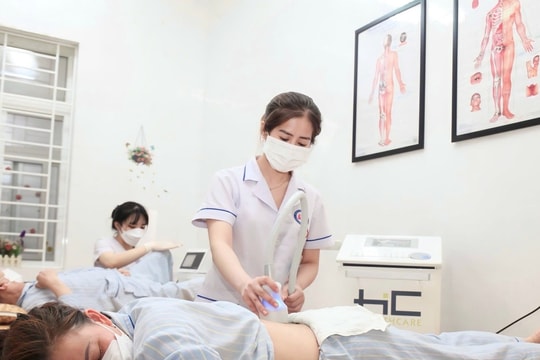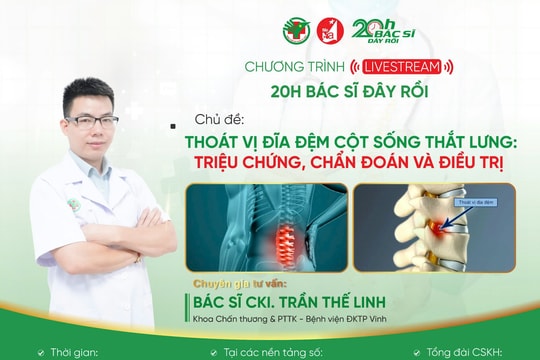Prestigious address for treatment of spinal disc herniation
(Baonghean) - Spinal disc herniation is one of the most common bone and joint diseases today. The disease not only appears in middle-aged and elderly people but also in young people.
Spinal disc herniation is a condition in which the nucleus pulposus of the spinal disc escapes from its normal position in the annulus fibrosus, compressing the spinal canal or spinal nerve roots. Pathologically, there is a rupture of the annulus fibrosus, clinically causing typical lumbar-hip syndrome (for lumbar disc herniation).
In addition, cervical disc herniation causes shoulder-arm neuralgia syndrome, or the patient may have shoulder and neck pain, stiff neck, arm muscle atrophy, hand paralysis, headache...; thoracic disc herniation also often occurs and clinically compresses the intercostal nerve roots, next to the spine causing intercostal neuralgia syndrome, the patient may have difficulty breathing, chest pain...
Elderly people often have degenerative disc disease, in which the annulus fibrosus loses its elasticity, so the nucleus pulposus easily breaks the annulus fibrosus to move backward or laterally when the spine performs daily movements, causing the spinal disc to be subjected to forces in all directions. Young people often have incorrect posture, causing the spinal disc to be compressed too heavily, leading to damage to the annulus fibrosus, such as when the spine is flexed, extended, and tilted.
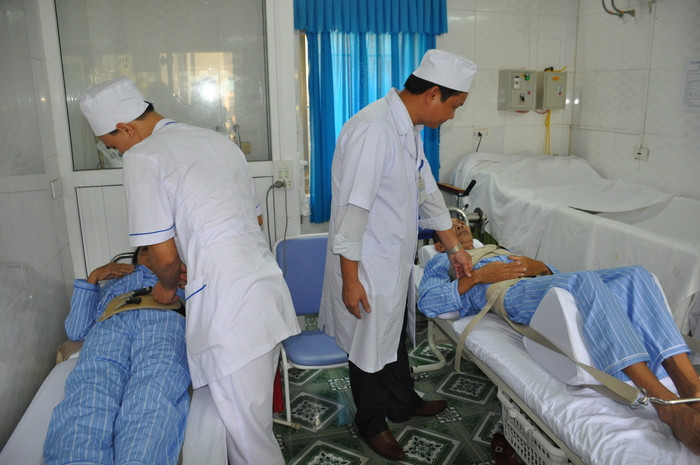 |
| Using lumbar spinal traction in the treatment of disc herniation. Photo: Thanh Hien |
Factors causing spinal disc herniation: High load pressure; High pressure of disc tissue swelling. Looseness in each part with the disintegration of disc tissue. Excessive pushing and twisting force compressing the spinal disc. Disc herniation often leaves dangerous consequences and complications such as compression of nerve roots, spinal cord causing symptoms of pain, numbness, muscle atrophy, and paralysis. When the nerve roots are damaged, the patient has difficulty moving the limbs.
If the brachial nerve is damaged, the patient cannot lift the arm or has difficulty bending or extending the arm, and the ability to work and live is seriously affected. The disease can leave dangerous consequences and complications for the patient. The patient may become disabled due to paralysis in the case of a herniated disc compressing the cervical spinal cord. When the nerves in the lumbar region are compressed, it can also lead to incontinence due to sphincter disorders. The limbs gradually atrophy, and the ability to work and move can be lost. Currently, up to 17% of people over 60 years old suffer from back pain due to lumbar disc herniation. The disease occurs in about 30% of the population, often occurring in the working age group from 20 to 55 years old.
In recent times, Nghe An Rehabilitation Hospital has had many effective methods of treating herniated discs. Many patients from all over the province and outside have come to Nghe An Rehabilitation Hospital to examine and treat herniated discs.
Patient Nguyen Van Nam in Hung Tan commune (Hung Nguyen) is 50 years old this year. He came to Nghe An Rehabilitation Hospital for treatment with a herniated disc compressing the nerve roots and spinal cord, causing symptoms of pain, numbness, muscle atrophy, and paralysis, leading to difficulty in movement. Initially, because he subjectively felt pain and stiffness in his muscles, he did not go to the doctor immediately but endured the pain and went to work as usual. Over time, the pain became more frequent, leading to numbness in his limbs and difficulty in movement. Mr. Nam said: After a period of treatment at Nghe An Rehabilitation Hospital, his condition has improved a lot. Currently, his pain has decreased, and he can move around more easily.
As for patient Ngo Duc Manh (Hung Phuc ward, Vinh city), 43 years old, a worker at a company. He was hospitalized with pain in the lumbar spine. At first, it was just minor pain, then the pain continued, greatly affecting his work. To treat Mr. Manh, Nghe An Rehabilitation Hospital had a specific treatment regimen combining Eastern and Western medicine such as physical therapy with infrared heat, paraffin, shortwave, electrolysis, pulsed electricity, interference... spinal massage...
Treatment methods
Master Thai Thi Xuan - Director of Nghe An Rehabilitation Hospital said: At Nghe An Rehabilitation Hospital, to effectively treat patients with spinal disc herniation, the hospital has proposed specific treatment regimens for patients according to the principle of combining drug treatment, rehabilitation and surgery; inviting leading experts and professors in neurology and rehabilitation as well as traditional medicine to support patients in examination and treatment, teaching, consulting and consultation...
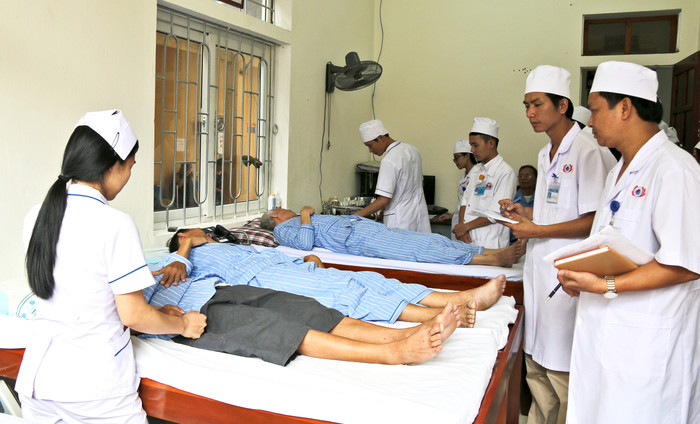 |
| Doctors and nurses from Nghe An Rehabilitation Hospital visit and examine patients being treated at the hospital. Photo: Thanh Hien |
Depending on the patient's condition, the hospital will determine how long or short the treatment will be. Specifically, the patient will receive intensive medical treatment for 1 to 3 months. If the patient's condition does not improve and the pain persists, surgery may be indicated. At the hospital, about 90 - 95% of all patients with spinal disc herniation are treated conservatively with internal medicine; about 5 - 10% are treated with surgery with specific rehabilitation methods and techniques such as:
In the acute phase, the patient rests in place, on a hard mattress, immobilized in a non-load bearing lying position. Physical therapy treatment with infrared heat, paraffin, therapeutic ultrasound, shortwave, electrolysis, electropulse, interference... Gentle passive, active, impedance and isometric muscle contraction exercises. After the acute phase, the patient's pain is relieved and can be treated with additional lumbar and thoracic spine traction, cervical spine traction with a spinal traction machine to increase the intervertebral foramina and reduce nerve root compression.
Physical therapy treatment with infrared heat, paraffin, ultrasound, shortwave, electrolysis, electropulse, interference...; exercise of all kinds. Exercises after spinal disc herniation surgery: 1-7 days after surgery, practice breathing, coughing, practice flexing the quadriceps and lower limb muscles, triceps, upper limb muscles, trapezius, neck and chest muscles... After 2 weeks, sit with a lumbar brace, chest brace, neck brace. After 3 weeks, you can sit up straight. The patient must wear a brace for 3 months; in addition, the hospital also gives specific instructions on home exercises to maintain the spine and good working posture.
The hospital prescribes other treatments such as medical treatment using painkillers according to the WHO ladder; anti-inflammatory drugs and topical anti-inflammatory drugs; muscle relaxants; slow-acting symptomatic drugs; IL1 inhibitors; local Corticoid injections, epidural block injections, facet joint injections. Vitamin B group drugs; Neurotransmitter enhancing drugs such as: Nucleo, Nivaline, Methylcoban, Galantamine, Dibencozide, Neurbion...
Laser or high-frequency radio wave treatment for disc decompression is often applied to mild cases such as disc protrusion and posterior longitudinal ligament herniation. There are some cases that can cause complications of discitis. In particular, surgical intervention is only performed after medical treatment is ineffective, or there is muscle paralysis, sphincter disorder, the purpose is to relieve nerve compression. However, post-surgical complications such as infection, nerve root damage, and post-surgical adhesions can also occur in patients.
For more effective treatment, Nghe An Rehabilitation Hospital also combines traditional medicine treatment such as using decoctions or pills. Depending on each type of disease diagnosed according to traditional medicine, there are different "treatment methods" according to the cube method. In addition, patients also receive spinal massage and adjustment by using the techniques of "Shot, press, squeeze, press, push" to impact the back and spine, following the path of the nerves corresponding to the diseased areas. Or use acupuncture (electroacupuncture or Laser acupuncture) depending on each location of the spinal disc herniation and the compressed nerve area to indicate the appropriate acupuncture points.
Disease prevention methods
According to Dr. Thai Thi Xuan, to prevent spinal disc herniation, we should have a healthy lifestyle, which is to maintain regular exercise, and should warm up well before starting to work. Maintain body mass index within normal limits (not too fat and not too thin).
Especially when standing, the posture must be straight, head straight, looking straight, shoulders back. When carrying heavy objects, do not twist the spine but bend the knees, straighten the back, and carry the object closest to the body. When working with soil and sand, keep the back straight by stepping one foot forward and bending the knee down, using the knee as a support point to work to avoid twisting the spine. At work, if you have to stand for a long time, you should use a low-backed chair to put your feet on, changing each side's foot every 5-10 minutes, placing it on the chair/time.
If you have to sit for long hours in the office or drive for a long time, you should take breaks to avoid muscle tension. Use a straight office chair to help keep your spine straight. When sitting at work, you can put your feet up a little higher than your groin. Use a swivel chair to limit twisting of the spine. In addition, you should pay attention to wearing a handbag on your shoulder rather than holding it in your hand. It is best to wear it evenly on both shoulders. When handling heavy objects, push the heavy object first, avoid pulling the heavy object as it can easily cause injury. Avoid wearing shoes or clogs that are too high (heels higher than 5cm). You should use soft material shoes.
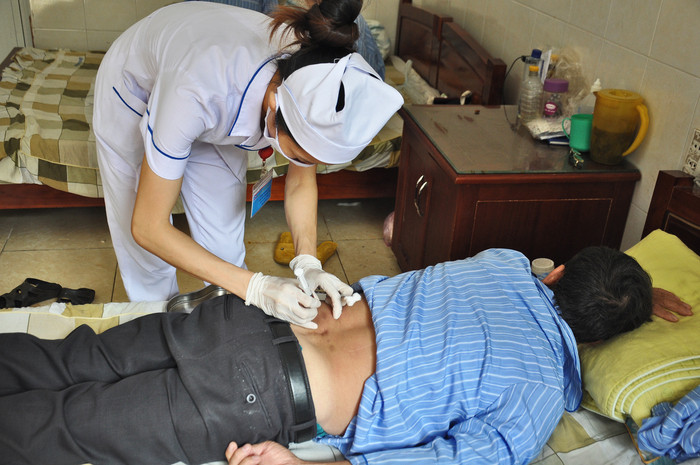 |
| Epidural injection treatment for spinal disc herniation at Nghe An Rehabilitation Hospital. Photo: Thanh Hien |
Scientific and Technical Council - Nghe An Rehabilitation Hospital. With the spirit: "All for the satisfaction of patients"; Is: "Where patients place their trust". Model: The first Green - Clean - Beautiful "Hospital - Hotel" in Nghe An.
| *Address: No. 220, Binh Minh Street, Cua Lo Town, Nghe An * Contact phone: - Clinic phone: 02383.949.709 - 24/7 hotline: 02383.952.020 - Hotline: 0966.251.414 - Hotline: 0912.002.210 - Director phone: 0912.487.568. |
Thanh Hien

